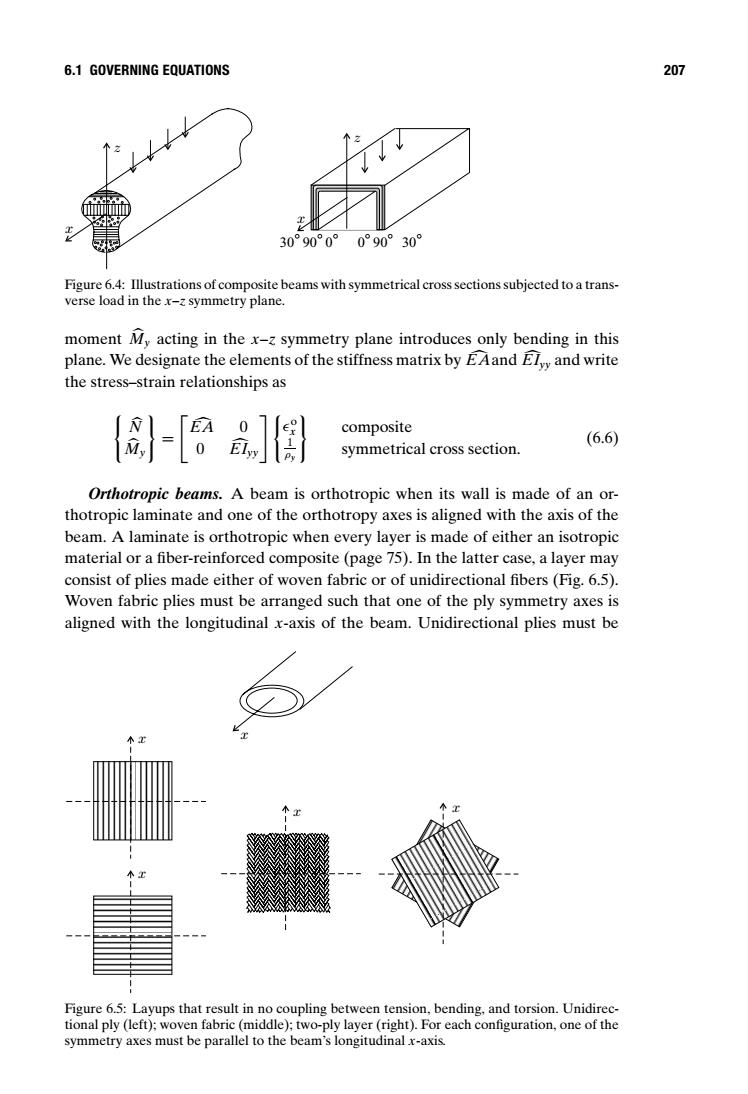正在加载图片...

6.1 GOVERNING EQUATIONS 207 30°90°0°0°90°30° Figure 6.4:Illustrations of composite beams with symmetrical cross sections subjected to a trans- verse load in the x-z symmetry plane. moment My acting in the x-zsymmetry plane introduces only bending in this plane.We designate the elements of the stiffness matrix by EAand E and write the stress-strain relationships as {-[] composite symmetrical cross section. (6.6) Orthotropic beams.A beam is orthotropic when its wall is made of an or- thotropic laminate and one of the orthotropy axes is aligned with the axis of the beam.A laminate is orthotropic when every layer is made of either an isotropic material or a fiber-reinforced composite (page 75).In the latter case,a layer may consist of plies made either of woven fabric or of unidirectional fibers(Fig.6.5) Woven fabric plies must be arranged such that one of the ply symmetry axes is aligned with the longitudinal x-axis of the beam.Unidirectional plies must be Figure 6.5:Layups that result in no coupling between tension,bending,and torsion.Unidirec- tional ply (left):woven fabric (middle):two-ply layer(right).For each configuration,one of the symmetry axes must be parallel to the beam's longitudinal x-axis.6.1 GOVERNING EQUATIONS 207 30° 90° 0° 0° 90° 30° z z x x Figure 6.4: Illustrations of composite beams with symmetrical cross sections subjected to a transverse load in the x–z symmetry plane. moment My acting in the x–z symmetry plane introduces only bending in this plane. We designate the elements of the stiffness matrix by EA and EI yy and write the stress–strain relationships as 1 N My 6 = / EA 0 0 EI yy0 1o x 1 ρy 6 composite symmetrical cross section. (6.6) Orthotropic beams. A beam is orthotropic when its wall is made of an orthotropic laminate and one of the orthotropy axes is aligned with the axis of the beam. A laminate is orthotropic when every layer is made of either an isotropic material or a fiber-reinforced composite (page 75). In the latter case, a layer may consist of plies made either of woven fabric or of unidirectional fibers (Fig. 6.5). Woven fabric plies must be arranged such that one of the ply symmetry axes is aligned with the longitudinal x-axis of the beam. Unidirectional plies must be x x x x x Figure 6.5: Layups that result in no coupling between tension, bending, and torsion. Unidirectional ply (left); woven fabric (middle); two-ply layer (right). For each configuration, one of the symmetry axes must be parallel to the beam’s longitudinal x-axis.����